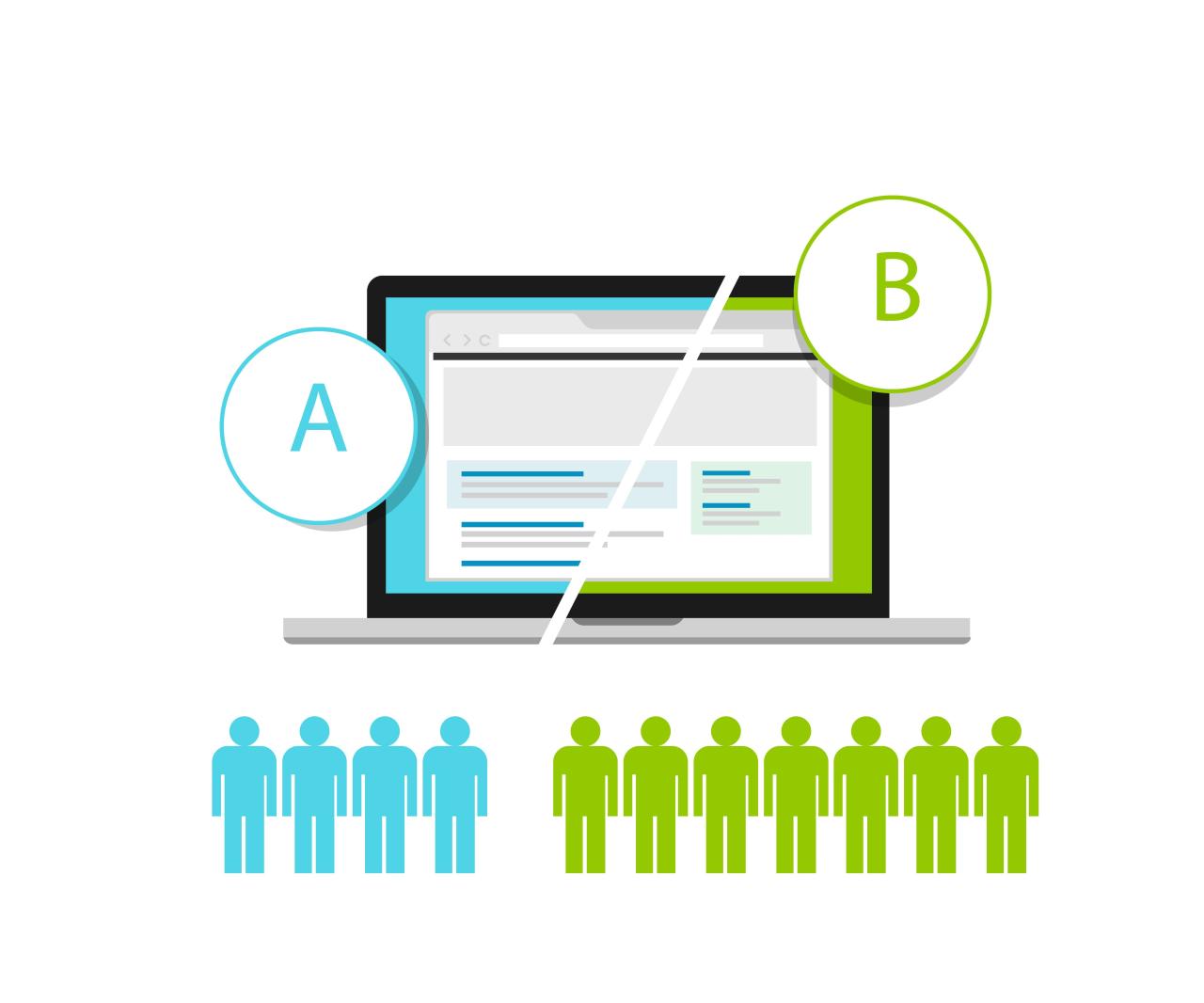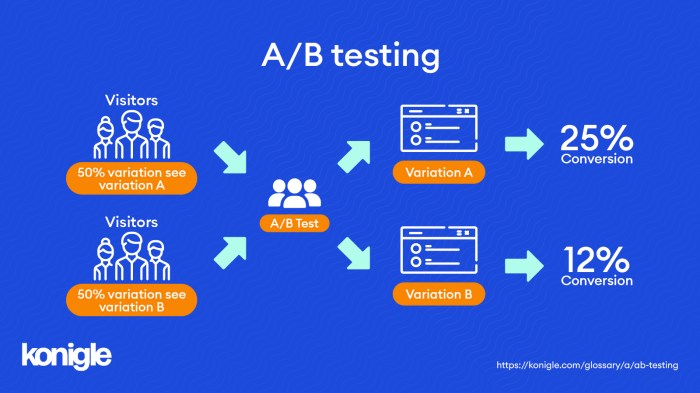Using A/B Testing in Marketing opens doors to maximizing marketing strategies with precision and insight. Dive into the world of data-driven decision-making and watch your campaigns soar to new heights.
A/B testing is a game-changer in the marketing world, allowing businesses to fine-tune their strategies for maximum impact. By testing different variables and analyzing results, companies can make informed decisions that drive success.
Introduction to A/B Testing in Marketing

A/B testing is a method used in marketing to compare two versions of a webpage, email, or other marketing assets to determine which one performs better. It involves splitting the audience into two groups and showing each group a different version. The version that generates a higher conversion rate or achieves the desired goal is then chosen for future campaigns.
Significance of A/B Testing
A/B testing is crucial in marketing as it allows businesses to make data-driven decisions rather than relying on assumptions or guesswork. By testing different elements such as headlines, images, or call-to-action buttons, marketers can understand what resonates best with their audience and optimize their strategies accordingly.
- Examples of A/B Testing:
- Testing two different subject lines in an email campaign to see which one results in higher open rates.
- Comparing two variations of a landing page to determine which layout leads to more conversions.
Benefits of Using A/B Testing in Marketing Campaigns
A/B testing offers numerous benefits to marketers, including:
- Insights into customer preferences: By testing different elements, marketers can gain valuable insights into what their audience responds to best.
- Improved conversion rates: Optimizing marketing assets based on A/B test results can lead to higher conversion rates and ultimately, increased revenue.
- Cost-effective decision-making: Instead of making changes based on intuition, A/B testing allows marketers to make informed decisions that are more likely to drive results.
Implementing A/B Testing
Implementing A/B testing in marketing involves several key steps to ensure accurate results and effective decision-making based on data-driven insights.
Setting Up an A/B Test
To set up an A/B test for marketing purposes, follow these steps:
- Determine the goal of the test, whether it’s to increase conversions, improve click-through rates, or enhance user engagement.
- Identify the variables to test, such as different headlines, call-to-action buttons, or page layouts.
- Split your audience into two random groups, the control group (A) and the test group (B).
- Run the test simultaneously to avoid external factors influencing the results.
- Measure the performance of each variant by tracking key metrics like conversion rates, bounce rates, and engagement levels.
- Analyze the data collected to determine the winning variant and implement the changes accordingly.
Tools and Platforms for A/B Testing
There are various tools and platforms available for conducting A/B tests, including:
- Google Optimize: A free tool that integrates with Google Analytics for seamless testing and optimization.
- Optimizely: A popular platform with advanced features for running A/B tests on websites, mobile apps, and other digital channels.
- Crazy Egg: A heat mapping tool that helps visualize user behavior and optimize web pages for better performance.
- Unbounce: A landing page builder with built-in A/B testing capabilities to improve conversion rates.
Best Practices for A/B Testing
When implementing A/B testing in marketing, consider the following best practices:
- Test one variable at a time to isolate the impact of each change on user behavior.
- Ensure your sample size is statistically significant to draw valid conclusions from the test results.
- Run tests for a sufficient duration to capture different user behaviors and account for any fluctuations in traffic.
- Document your test hypotheses, results, and learnings to inform future testing strategies and optimizations.
- Iterate and refine your testing process based on insights gained from previous tests to continuously improve your marketing performance.
Choosing Variables to Test
When it comes to A/B testing in marketing, choosing the right variables to test is crucial for optimizing your campaigns and maximizing performance. By identifying key variables and prioritizing them effectively, you can make data-driven decisions that drive success.
Identifying Key Variables
In marketing, there are several key variables that can be tested using A/B testing to determine their impact on performance. Some common variables include:
- Headlines and copy
- Call-to-action buttons
- Images and visuals
- Pricing strategies
- Email subject lines
- Landing page layouts
Testing these variables allows you to understand what resonates best with your audience and drives the desired actions.
Prioritizing Variables to Test
Prioritizing which variables to test first in a marketing campaign is essential for efficient testing and optimization. To prioritize variables effectively, consider factors such as:
- The potential impact on key performance indicators (KPIs)
- The level of uncertainty or risk associated with the variable
- The ease of implementation and testing
- The alignment with your overall marketing goals
By focusing on variables that are most likely to have a significant impact on your KPIs and are relatively easy to test, you can prioritize your testing efforts for maximum results.
Impact of Testing Different Variables
Testing different variables in your marketing campaigns can have a significant impact on overall performance. By systematically testing and optimizing variables, you can:
- Improve conversion rates and lead generation
- Enhance customer engagement and satisfaction
- Increase revenue and return on investment (ROI)
- Gain valuable insights into your target audience and their preferences
Overall, testing different variables allows you to make data-driven decisions that drive success and continuously improve your marketing efforts.
Interpreting A/B Test Results

When it comes to analyzing and interpreting the results of an A/B test, it’s essential to look beyond just the surface numbers. You need to consider statistical significance, confidence intervals, and practical significance to draw meaningful conclusions. By understanding these key aspects, you can make informed decisions to optimize your marketing strategies.
Common Pitfalls to Avoid
- Avoid stopping the test too early: Make sure to let the test run for a long enough period to gather sufficient data and ensure reliable results.
- Avoid ignoring statistical significance: Always pay attention to the statistical significance of your results to determine if they are valid and not just due to random chance.
- Avoid cherry-picking results: Don’t just focus on the outcomes that support your hypothesis; consider all data points to get a comprehensive view of the test results.
Drawing Actionable Insights
- Identify patterns and trends: Look for consistent trends across different segments of your audience to understand what is working and what needs improvement.
- Segment your data: Analyze the results based on different demographics, behaviors, or other variables to tailor your marketing strategies more effectively.
- Test hypotheses: Use the insights from your A/B test results to form new hypotheses and continue testing to refine your strategies and achieve better outcomes.
Case Studies and Success Stories: Using A/B Testing In Marketing
When it comes to A/B testing in marketing, real-world examples of companies that have successfully utilized this strategy can provide valuable insights into its effectiveness. Let’s take a look at some case studies and success stories that showcase the impact of A/B testing on marketing campaigns.
Netflix
One notable example of successful A/B testing in marketing comes from Netflix. The streaming giant used A/B testing to optimize its user interface and personalize recommendations for viewers. By testing different variations of the homepage layout, content recommendations, and call-to-action buttons, Netflix was able to improve user engagement and retention rates significantly.
- Outcome: The A/B testing resulted in a 10% increase in user engagement and a 5% decrease in subscription cancellations.
- Impact: By implementing the findings from A/B testing, Netflix was able to enhance the overall user experience and retain more subscribers.
- Strategies: Netflix focused on testing small changes iteratively, analyzing user behavior data, and implementing data-driven decisions to achieve positive results through A/B testing.
Airbnb, Using A/B Testing in Marketing
Airbnb is another company that has leveraged A/B testing to improve its marketing efforts. The online marketplace for lodging used A/B testing to optimize its search algorithm, pricing strategies, and email marketing campaigns. By testing different variables such as pricing display, search result ranking, and email subject lines, Airbnb was able to enhance user experience and increase booking conversions.
- Outcome: The A/B testing led to a 15% increase in booking conversions and a 20% improvement in email open rates.
- Impact: By utilizing A/B testing, Airbnb was able to drive more bookings, improve customer engagement, and boost revenue.
- Strategies: Airbnb focused on segmenting its audience, testing multiple variables simultaneously, and analyzing performance metrics to optimize marketing campaigns through A/B testing.
